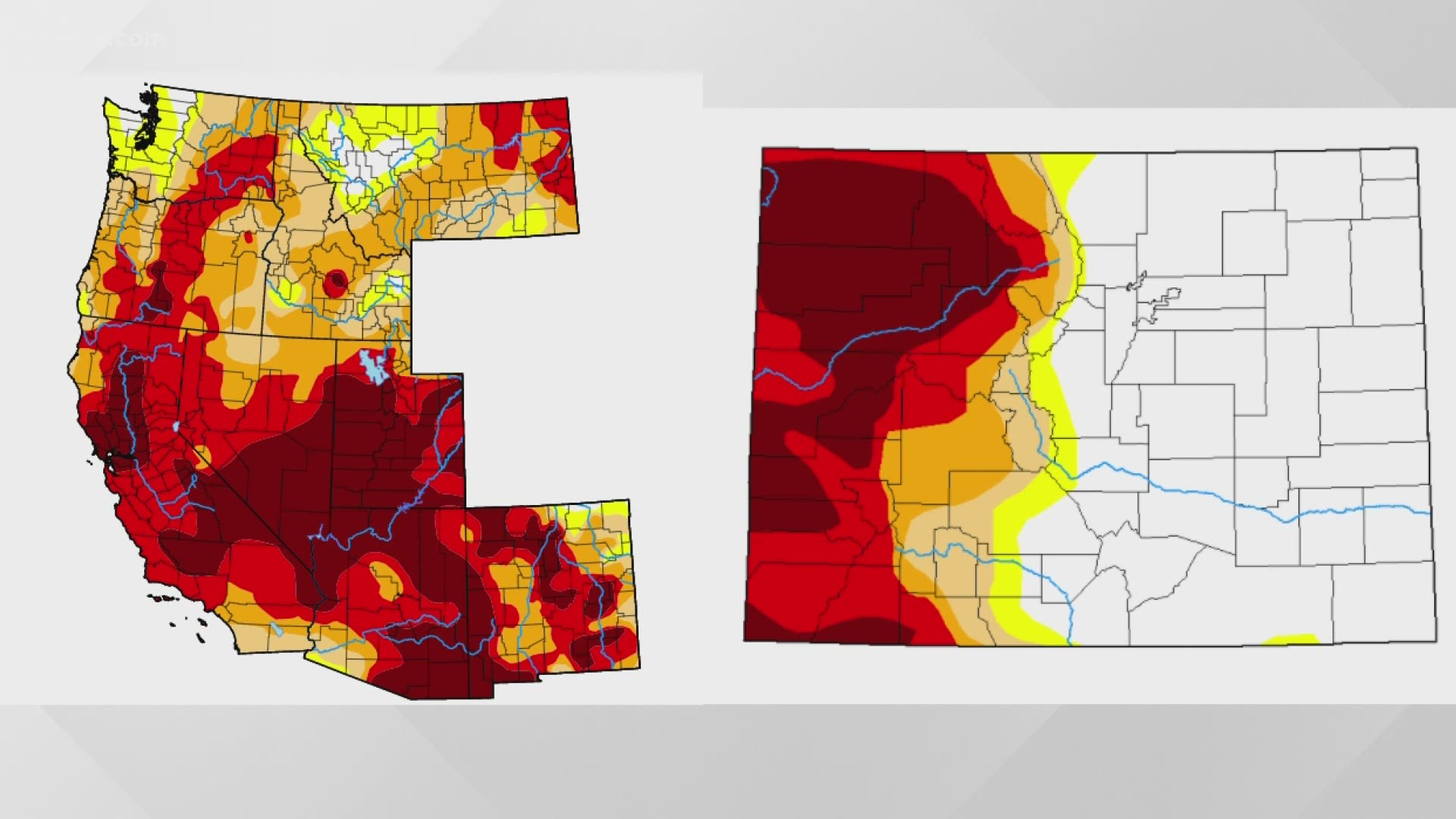GUNNISON COUNTY, Colo. — On the side of a dirt road in Gunnison County, a herd of cattle cool off in the water of an irrigation ditch.
Doug Washburn, range manager for Spann Ranches in southwestern Colorado, points at the hills surrounding the operation’s northern headquarters.
>> Video above: Drought levels looking more severe this year
“It's not as bright and as green as you would think, just because the ground itself is so parched,” Washburn said.
Colorado’s Western Slope is considered a climate hot spot where temperatures are increasing faster than the global average. This warming has contributed to more than 20 years of dryness, which scientists are calling a megadrought.
Ranchers like Washburn try to adapt. That might mean having to give up ranching.
> This story is powered by COLab, the Colorado News Collaborative. 9NEWS joined this historic collaboration with more than 40 other newsrooms across Colorado to better serve the public.
Washburn is raising the sixth generation of kids on the ranch, which has operated in Crested Butte for more than 130 years. He said that just in the past 20 years, there’s been a noticeable difference in the amount of available water.
Washburn grows hay on his private acreage while his cows graze on federal land. Some of the smaller creeks and ponds that irrigate the government rangeland are drying up.
“Year after year of this continued drought, we're seeing places that we didn't think would ever go dry,” Washburn said.
One creek dried up three years ago. Washburn said his father-in-law had never seen that creek go dry in his life.
Without enough water on their federal pasture, Spann Ranch is bringing its cattle back to the private ranch weeks earlier than they’re supposed to. That’s a costly snag. Without open grazing, ranchers are forced to use their winter hay supplies early to feed their hungry cattle during the summer. When the hay runs out, they have to buy more.
“Raising cattle in Crested Butte is not the most profitable operation anyway,” Washburn said, laughing. “But if you have to buy feed for them, then it really doesn't work out too well.”
Most of the farmland in this county is irrigated, meaning farmers and ranchers flood their crops and pastures with river water.
Farmers and ranchers started digging this system of trenches and ditches more than 100 years ago, transforming the landscape. What was once sagebrush and rocks is now meadows of hay and grass. Colorado’s agricultural industry depends on this water, but more than 20 years of deep drought has depleted this critical resource.
Washburn said he believes that the lack of water on the Western Slope will mean the end of his family's ranching operation within his children's lifetime.
Andy Spann, Washburn’s brother-in-law and part-owner of the ranch, said climate change likely means the ranch won’t be able to continue doing business the way it has for six generations.
“If we keep having dry winters and dry summers, things are going to change significantly,” Spann said.
Spann said he believes his family can stay in agriculture, but the operation will need to change. Right now, their business is raising and selling calves. That requires a lot of hay to feed mother cows during the winter.
Instead, Spann said they might move to raising cattle during the warmer months and selling off any hay they are able to grow.
More drastic options include transitioning from cattle ranching to growing hay full-time — or even turning the livestock operation into a horse ranch, Spann said.
Worst case, the Spann family might have to leave agriculture entirely. Spann said his grandfather is worried the ranch could be a golf course in the future. That’s a grim but realistic outcome, Spann said.
Bill Parker, another Gunnison County rancher, said his operation is already successfully adapting to climate change.
Parker learned hard lessons from previous droughts, including the historic drought of 2012 that forced him to sell off half his animals for close to a loss.
“Those are the kind of experiences that just really stick with you, and you want to figure out how to avoid that again,” Parker said.
If a bad drought year is forecasted, ranchers like Parker won’t raise as many animals. That usually means less potential profits, but Parker raises grass-finished beef and lamb that fetch a premium when he sells the meat directly to wholesalers locally and online.
Parker said his family uses direct marketing to pocket as much of the retail dollar as possible. Without a middleman, Parker can make more money by raising fewer animals instead of feeding and caring for a large herd when it’s abnormally dry.
Parker also moves his livestock to warmer places in the winter so they can continue grazing on grass, which means his operation isn’t dependent on a good hay crop.
He’s also adopted other climate-friendly ranching techniques. Instead of letting his sheep or cattle overgraze one spot, he moves them around using a portable electric fence. Parker said this allows him to control the health of his soil.
The technique, called rotational grazing, keeps the animals from eating all the plants before they can grow the deep roots that help hold moisture in the soil. Healthy soil and plants also absorb carbon from the atmosphere, which can help fight climate change.
Parker could get federal drought insurance and get compensated during dry years, but he doesn’t. He said he wants to take responsibility for ranching in the arid West, a burden that’s growing heavier as the climate warms.
RELATED: Full capacity, not enough staff: Local restaurants make service changes amid hiring challenges
SUGGESTED VIDEOS: Latest from 9NEWS

